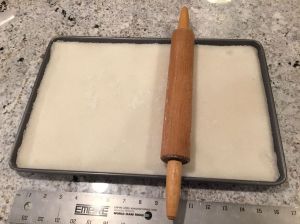
Making sugar cakes on December 3. © Erik Brown
My friend Gordon used to say that it takes three years to become a good teacher. We were teaching secondary school in Botswana, Africa at the time, preparing students for their O-level and A-level exams. Gordon said that you spend the first year figuring out the material, the second year figuring out how to teach, and the third year really teaching. Of course, I only taught for two years, so it never quite happened for me.
This may apply to how beekeepers overwinter bees as well. I read and learned much and stumbled through my first winter. As we enter my second winter I have stronger opinions about what I should have or could have done better. Next year I will be perfect.
The northern winds have really picked up lately, making me doubly glad that I turned Saturn around in November. I was out of town for a couple days, and am now flying over this crazy country returning home. We are not yet into winter, though I am thinking about my bees and wondering how they will fare going into spring.
Beekeeping is local, so here are some things I could have done better this year, and seem to be important for our Virginia area.
Summer Feeding
In a recent local talk by Dr. Kirsten Traynor , who keeps bees in nearby Maryland, she talked about the importance of feeding bees in late July and early August. This keeps the queen laying to create healthy bees for winter, and preserves the food stores during our summer nectar dearth and often weak fall flow.
My hives had plenty of stores in early August, so I didn’t feed them. In September I was rather dismayed to find my hives running out of food, especially Ganymede. I fed them what I could before the cool weather arrived.
In some ways I hate to feed bees processed sugar and water, but not as much as having winter bees with no food. So I will feed the hives towards the end of summer next year.
Winter Insulation

Putting new insulation on Saturn November 24. © Erik Brown
Our Virginia winters are not that bad, with many days over 40 and occasionally warm enough for the bees to fly. We usually have a month of two of consistently below freezing weather, and that’s about it.
This year I insulated the tops of the hives, as I did last year. In theory the extra insulation on top forces any condensation from moisture to occur on the outside of the hive, away from the clustering bees.
Last year I used one-inch foam insulation. The top cover is not much thicker, so the cover sort of floats above the frames, necessitating a strap for the hive. This year I used 3/4 inch (just under 2 cm). Not as hardy an insulation, though should be good enough for our winters, and allows the cover to fit a bit more snugly on top of the hive.
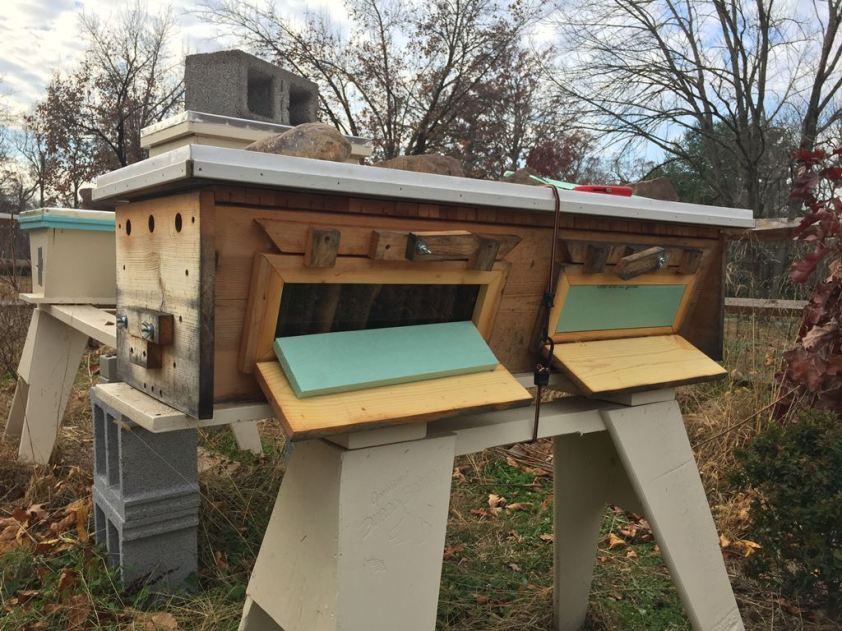
I insulated the open space in the observation windows on Venus this as well. Last year the bees shied away from this side, presumably from the wind and cold. The gap is 3/4 inch, so the insulation was an exact fit. © Erik Brown
Varroa Control
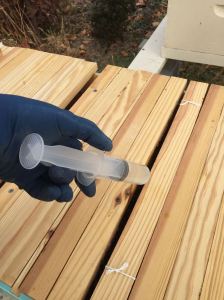
Applying an OAD to Saturn on November 28. © Erik Brown
I had mixed results with mites this year. I checked my levels every month or so, and tried to treat when the rate of infestation was high. I did an early spring treatment with formic acid, which was a bit of a disaster. The mites were knocked back, but Mar’s queen stopped laying and Venus’ queen disappeared. So the hives did not expand well and neither hive stored a lot of honey.
I would prefer avoiding the use of chemicals, so I may try to do drone trapping. This was also described by Dr. Traynor in her talk. It seems easy enough, you just have to get into the brood nest every few weeks to remove the capped drone cells.
Really like having screened bottom boards on Mars and Jupiter to check the mite levels during cold weather. I pull the boards every few days, count the mites, clean them off, and put them back. My levels in Mars were high, over 10 per day, and Jupiter had jumped from almost nothing to around 7 per day.
As a result, I tried my hand at an oxalic acid dribble (OAD). This natural chemical occurs in spinach, rhubarb and other plants, so the bees have some built-in resistance. It works best in cold weather when the hive is clustered and there is very little brood. The picture here shows me dribbling Saturn in near freezing weather, with the top bars spread slightly apart. The treatment is 5 ml of oxalic-laden sugar syrup per seam of bees. Not an easy task, as it turned out, even though I practiced ahead of time.
I thought my treatment might be a complete failure when three days later (December 1) the drop on my bottom boards was not very different: 50 mites from Mars, or 16+ per day, and 8 mites from Jupiter, almost 3 per day. Fortunately, an additional three days later Mars had dropped 208 mites, or 69+ per day, so I felt better. Jupiter was still around 3 per day, so either she was never so bad off or the mites are hiding in brood cells.
I treated all five hives, so hopefully the mites will be knocked down going into spring. I hope to avoid spring treatments so bees can take full advantage of any nectar in our area.
Winter Feeding
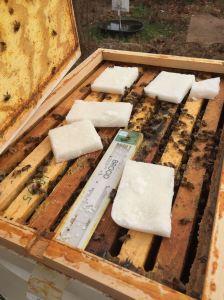
Feeding Ganymede. © Erik Brown
I used sugar bricks last year, although the bees had enough stores and did not really eat them. I made some last weekend. The hives are probably okay for December, except for Ganymede who was almost out of stores in October. I fed her syrup while I could, but I’m pretty sure she is light on food.
The picture shows a few bricks on Ganymede. There wasn’t enough room on top of the hive so I had to add a one-inch shim. This has a small hole to ventilate moist air and gives room for my sugar cakes. Unfortunately it is too cold now for the bees to seal the new shim onto the hive, so this will create an extra draft. This should be okay as long as they have food.
Note to self: add shims for feeding to the hives in the fall so the bees can seal the cracks before the cold sets in. If I’m worried about robbing, tape over the holes.
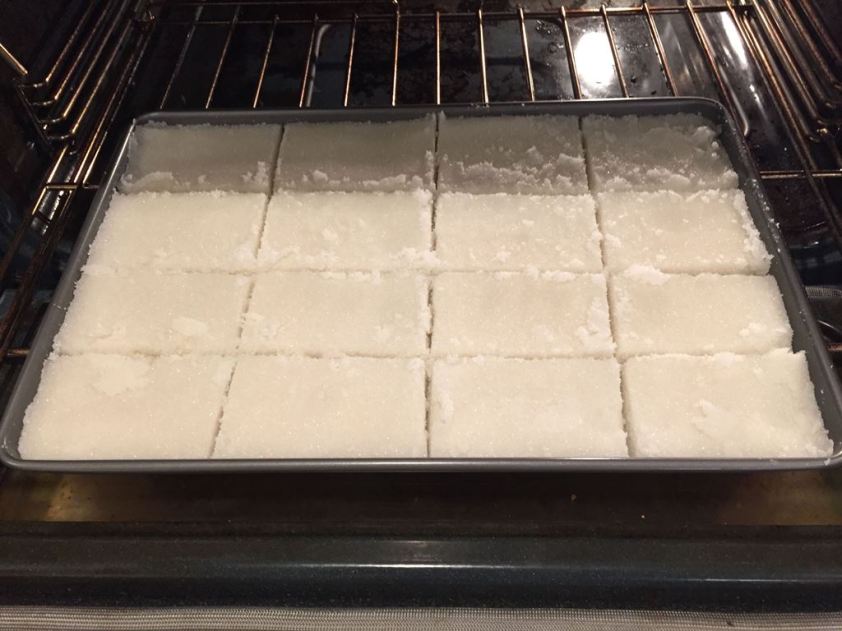
Sugar bricks fresh from the oven. I rolled this sheet the night before and cut the small squares with a pizza cutter as suggested on beesource.com. Heated our electic oven to its lowest setting before turning it off so the sugar could dry overnight. © Erik Brown
Next year will be better
That’s it. Feed the bees during the summer dearth, try to deal with mites through manipulations rather than chemicals, and prepare the hives for winter before it is too cold outside. Unless I change my mind, of course.
[Updated 12/10: I had incorrectly quoted Dr. Milbrath as having bees in Maryland and talking about drone trapping, which was not true. I was actually thinking of Dr. Kirsten Traynor’s talk at the Virginia state meeting. I corrected this in the post.]
Winter weather and women’s thoughts change often
This slightly sexist proverb appears in my Dictionary of American Proverbs. According to the book, it originated around 1450 and appeared in a 20th century collection Songs and Carols by Stevenson, perhaps on page 360. I couldn’t locate the exact reference. The phrase turns up on a few sites in a Google search, though no one has any further insight about its origins.
Given this was about my evolving thinking on hives in winter, it seemed like a fitting title. I’m sure these thoughts will change next year as well.
Enjoy the season!
“Unless I change my mind, of course.”
ROFL! That seems to be the story of my whole beekeeping experience. I think I have things figured out, then the next season, something happens to make me do a 180 in my thinking — or add a 90 degree turn at a minimum.
But you’re right about needing at least 3 years. As I finish up my fourth summer, I realize that I still know nothing, but I’m much more comfortable with that. 🙂
Hope your bees thrive and prosper this winter!
LikeLike
Thanks, Julie. It does seem to be how it goes. Two steps forward, three steps back. Hope your bees have a nice, warm winter.
LikeLike
May we request clarification on a few items? Dr. Milbrath lives in Michigan. Does she really have an outyard in Maryland? And who is Dr. Merideth? The link goes to the same post about Dr. Milbrath’s talk.
And we, too, could relate to the “Unless I change my mind” line. Consider the oft-mentioned “2 beekeepers, 3 opinions” or variation thereof. Simple math indicates that any single beekeeper will contrarily have more than one opinion. What gets done depends on which of the voices in the head spoke loudest that day.
LikeLike
Oh man, just me getting my facts totally wrong! I’d say this will teach me to post too quickly, though it probably won’t. I was thinking of the recent Virginia State Beekeepers Association meeting where Dr. Kirsten Traynor spoke. Thanks for catching that, and I have corrected the post.
Totally agree with the voices in the head syndrome. As a young beekeeper I am easily influenced, perhaps. Next year everything will be better, I am sure.
LikeLike